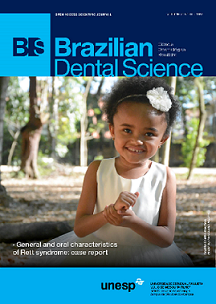Stress and strain distributions on short implants with two different prosthetic connections – an in vitro and in silico analysis
DOI:
https://doi.org/10.14295/bds.2017.v20i3.1433Abstract
Objective: An ideal biomechanics minimizes the stress between implant and bone that can provide success for osseointegrated implants. This study evaluated the strain concentration in surrounding tissue and stress in the components of two implants with different prosthetic connections through an in vitro and in silico methods. Methods: Twenty polyurethane blocks were divided into two groups (n=10) followed by the installation of internal hexagon (IH) (AS Technology – Titanium Fix, São José dos Campos, Brazil) or locking taper implants (LT) (Bicon Dental Implants). For strain gauge (SG) method, four sensors were placed around the implants. For finite element analysis (FEA), the same block was modeled and analyzed. An axial load (30 kgf) was applied for both methodologies. The values of stress and strain were analyzed for correlation to SG. Results: For SG, LT presented a mean of strain most aggressive (-932) than IH (-632). For FEA, LT showed less stress (-547) then IH (-1169). Conclusion: For two implant’s system, microstrain values capable to induce unwanted bone remodeling were not measured. However, for IH implant, the presence of a retention screw has the disadvantage to concentrate stress while a solid abutment dissipates the axial load through the implant that suggests a better performance for LT group.
Keywords: Finite elements analyses; Dental implant; Strain gauge.
Downloads
Downloads
Additional Files
Published
How to Cite
Issue
Section
License
Brazilian Dental Science uses the Creative Commons (CC-BY 4.0) license, thus preserving the integrity of articles in an open access environment. The journal allows the author to retain publishing rights without restrictions.
=================




























